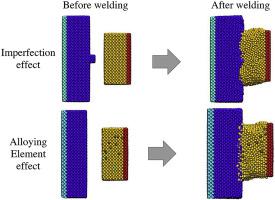Journal of Molecular Graphics and Modelling ( IF 2.7 ) Pub Date : 2020-08-15 , DOI: 10.1016/j.jmgm.2020.107712 M Khodakarami 1 , A Farzadi 1 , A Ramazani 2

|
There are many physical phenomena and properties associated with diffusion in linear friction welding (LFW) process. Many of these phenomena are not observable by known and conventional methods. The molecular dynamics (MD) is an advantageous and practical method to study the diffusion process and atomic behavior of welded materials. In the current research, we used MD simulations to model the LFW process between copper and nickel metals. The effect of defects in the structures and also the addition of alloying elements to the copper structure was also studied. Our findings revealed that the surface and subsurface imperfections in the copper structure were gradually eliminated in the friction stage. In contrast, these imperfections in nickel structure disappeared in the forging stage. Also, we showed that adding alloying elements to copper structure leads to an increase in the amount of the mean square displacement (MSD) of the atoms and the diffusion coefficient in copper.
中文翻译:

合金元素和缺陷对Cu和Ni金属的线性摩擦焊接的影响的分子动力学研究。
线性摩擦焊接(LFW)过程中存在许多与扩散相关的物理现象和特性。通过已知和常规方法无法观察到许多这些现象。分子动力学(MD)是研究焊接材料扩散过程和原子行为的一种有益而实用的方法。在当前的研究中,我们使用MD模拟对铜和镍金属之间的LFW过程进行建模。还研究了结构缺陷的影响以及向铜结构中添加合金元素的影响。我们的发现表明,在摩擦阶段,铜结构的表面和亚表面缺陷逐渐消除。相反,镍结构的这些缺陷在锻造阶段就消失了。也,











































 京公网安备 11010802027423号
京公网安备 11010802027423号